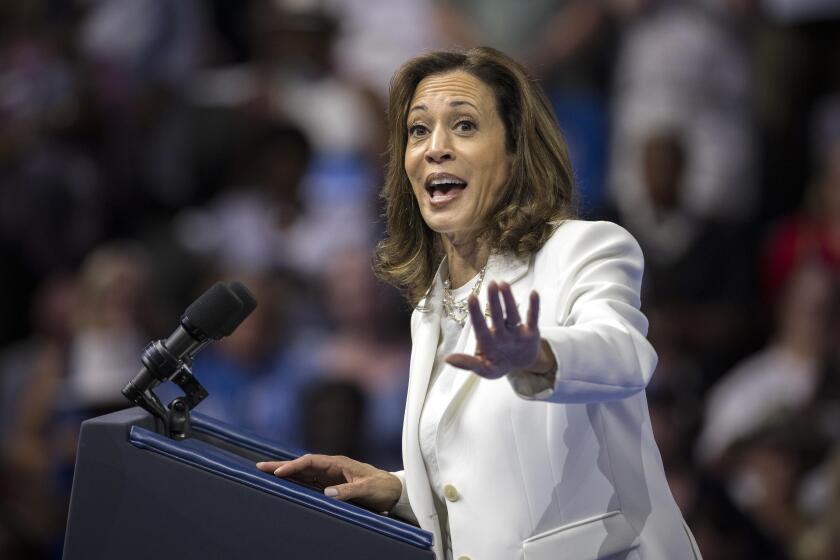Op-Ed: What to do about L.A.’s sky-high rents
The most fundamental problem Los Angeles faces is that a huge number of Angelenos can’t even afford to live here. Their pay is too low; their rent is too high.
Last week, the real estate website Zillow released a survey commissioned by the New York Times that identified the 90 American cities where the median rent exceeded 30% of the median household income. (The 30% figure is the threshold at which rent is generally deemed unaffordable.) The survey ranked those 90 cities by the percentage of their residents’ median income devoted to their median rent. In Los Angeles, that figure was a mind-boggling 47%, which put the City of Angels in first place by a wide margin.
The list of 90 cities makes for instructive reading. It includes localities with relatively high median incomes, like San Francisco and New York, where property values and rents have soared to stratospheric levels. It includes poverty-stricken cities like Salinas or Hattiesburg, Miss., where rents are low but incomes are lower still. To come in first by so large a margin, Los Angeles had to excel in both categories: A vast portion of the city’s workforce is underpaid; a vast portion of the city’s housing stock is unaffordable.
According to a report released last year by the Los Angeles Economic Roundtable, 46% of the city’s wage and salary workers make less than $15 an hour. In the post-World War II decades, when Los Angeles was the nation’s largest hub of aerospace manufacturing and its second-largest center of auto manufacturing, the city’s working class was more highly unionized and better paid. As factories closed, however, and service-sector jobs took their place, wages went down. From 1979 to 2011, the median inflation-adjusted annual pay in Los Angeles declined by 14%, even as housing costs continued to rise sharply.
The high share of income that Angelenos pay for housing means a lower share of income spent on the rest of the local economy. Purchases of food, clothing and everything else suffer. The Los Angeles economy suffers from this lack of aggregate demand. And L.A.’s air quality suffers from the long car commutes that Angelenos who have moved to distant suburbs for affordable housing must undertake daily.
State and federal policy are partly to blame for this crisis of unaffordability. The state’s abolition of redevelopment agencies and the exhaustion of its fund for below-market housing bonds have dried up much of the money that subsidized the construction of affordable housing. Federal funding for affordable housing and rent subsidies has dwindled as well, even as federal trade policy has hastened the exit of manufacturing jobs.
Some of these problems could be remedied at the state level. A bill in the California Senate, SB 391, would re-create an affordable housing fund by instituting a $75 fee for recording real estate documents. Legislators could also scrap a state law that prohibits cities from requiring developers to build affordable housing units in return for permitting them to construct market-rate units.
Still, there are significant actions that Los Angeles could take by itself that would relieve the burden its residents face. The most significant would be to raise the citywide — or better yet, the countywide — minimum wage to $15 an hour. Such an increase, the Economic Roundtable has calculated, would raise the wages of 811,000 city residents, reducing the share of their income that goes to housing and increasing the share that goes to local purchases. Annual sales in L.A. County would increase by an estimated $9.2 billion, leading to the creation of tens of thousands of jobs.
The recently released report of the city’s 2020 Commission called for raising the local minimum wage over the $10 hourly figure set last year by the state. As yet, local elected officials have been slow to respond to this call.
The impulse to implement a back-to-basics agenda — a commitment to greater governmental transparency, street repair and the like, which Mayor Eric Garcetti has called for — is commendable as far as it goes. But the basics of Los Angeles life for half the city are defined and delimited by the impoverishing combination of low-paying jobs and unaffordable rents. This is the most basic of L.A.’s basics, and the one the city’s leaders most need to address.
Harold Meyerson is the editor at large of the American Prospect and an op-ed columnist for the Washington Post.
More to Read
A cure for the common opinion
Get thought-provoking perspectives with our weekly newsletter.
You may occasionally receive promotional content from the Los Angeles Times.










